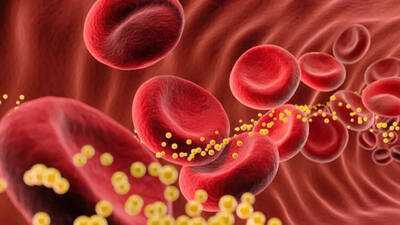
In today’s world of hyper-wellness-awareness, we often associate the word “fat” with everything “unhealthy” — we believe, all sorts of diseases and health hazards that could derail our lives stem from it. But here’s the thing: fat in the bloodstream isn’t always a bad thing — it’s essential. But when levels get too high, it becomes a hidden danger. One such measure is triglycerides .
Every so often, it’s easy to overlook the different types of fats in our bodies. Yet one fat, in particular, plays a pivotal role in our health — and that is the lipid known as Triglycerides. Though essential for energy storage and metabolism, when triglyceride levels rise beyond healthy limits, they can contribute to serious health problems.
What are triglycerides?
These are a type of fat that our bodies use and store, yet if left unchecked, they may contribute to serious health risks. Triglyceride is one of them.
Triglycerides are a type of fat (lipid) found in your blood. When you eat more calories than your body immediately needs — especially from fats, sugars, and refined carbohydrates — your body converts the excess into triglycerides and stores them in fat cells for later use. They consist of three fatty acids attached to a glycerol backbone.
Triglycerides serve as a fuel reserve: when your body needs energy between meals or during activity, hormones release triglycerides from storage for cells to use.

Why and how do they matter for your health?
Triglycerides (TGs) are a form of fat (lipid) found in the blood. After you eat, any calories your body doesn’t immediately use can be converted into triglycerides and stored in fat cells. Later, your body releases them for energy between meals. This process is normal — triglycerides are part of how the body manages energy.
Having triglycerides within a healthy range is normal and necessary. But chronically high levels — a condition known as hypertriglyceridemia — are a risk factor for a range of health issues. For example, elevated triglycerides are associated with a greater risk of heart disease, stroke, and hardened arteries (atherosclerosis). Very high levels may even trigger inflammation of the pancreas (pancreatitis).
Your blood test will give a “triglyceride level” (commonly in milligrams per deciliter, mg/dL). According to the :
Less than 150 mg/dL is considered within the normal range.
150-199 mg/dL is “borderline high”.
200-499 mg/dL is “high”.
500 mg/dL or more is “very high”.
Why elevated triglycerides matter
When triglyceride levels are elevated, they reflect underlying metabolic stress — too many unused calories,/or the body is less efficient at clearing fats from the blood. High triglycerides are linked with a greater risk of heart disease and stroke.
According to , the risk of heart problems may rise even when levels exceed ~89 mg/dL, not just the classic “150” threshold.
Other risks of very high triglycerides include the possibility of acute pancreatitis (inflammation of the pancreas) when levels are extremely elevated.
In essence, while triglycerides may not be as well-known as “bad cholesterol,” they matter. They signal how well your body handles and stores fat. Treating high triglycerides means treating a broader metabolic and cardiovascular issue.

What causes triglycerides to rise
Several lifestyle and bodily factors might be responsible for an elevated triglyceride level, such as:
Eating more calories than you burn — especially from refined carbohydrates (white bread, sweets) and alcohol.
Being overweight (especially carrying excess weight around the waist) and insufficient physical activity.
A diet high in saturated fats, trans fats, or simple sugars.
Underlying conditions such as poorly controlled diabetes, low thyroid, kidney disease, and liver disease.
Genetics — some rare inherited conditions cause very high triglyceride levels.

How to bring triglyceride levels down
Although an elevated level of triglyceride poses serious threats to health, the good news is that, for many people, certain lifestyle changes can make a major difference.
Adjust your diet: First and foremost, reduce simple sugars and refined carbohydrates (like white bread, white rice, sugary drinks) — these boost triglyceride formation. Limit saturated fats and trans-fats (found in red meat, full-fat dairy, fried foods) and choose healthier fats (unsaturated fats, oily fish). In addition, increase fiber: whole grains, legumes, vegetables, and fruit. Fiber helps slow the absorption of fats and sugars. Furthermore, limit or avoid alcohol, even moderate drinking may raise triglycerides.
Get regular physical activity and manage weight: Aim for at least 150 minutes per week of moderate-intensity aerobic exercise (e.g., brisk walking), which can reduce triglycerides by 20-30% or more. Moreover, losing excess weight always helps. Even modest weight loss (5–10% of body weight) has been shown to lower triglycerides significantly.
Check and manage underlying health conditions: If you have diabetes, thyroid disease, liver or kidney issues — treating those can help bring triglycerides down.
Medication (if needed): If triglycerides are very high (especially > 500 mg/dL), or if lifestyle changes aren’t enough, doctors may prescribe medications (e.g., fibrates, omega-3 fatty acid formulations) to reduce the levels and prevent complications.
-
Russian Chopper Breaks Into 2 Parts Before Crashing Near Caspian Sea; 5 Killed: WATCH

-
ABP Exclusive: Raja Raghuvanshi Murder Case Chargesheet Reveals Sonam's Chilling Plot, 2 Failed Attempts

-
'Stop Treating Your Body Like Garbage': Medical Student Urges People To Rethink Eating Habits To Avoid Chronic Diseases

-
Oppo Reno 15 Series Is Set For Launch On November 17, Will Feature Triple Rear Camera Setup

-
SSC Opens Self-Slot Selection Facility For JE And SI Exams 2025 Today; Here's How To Choose A Slot
